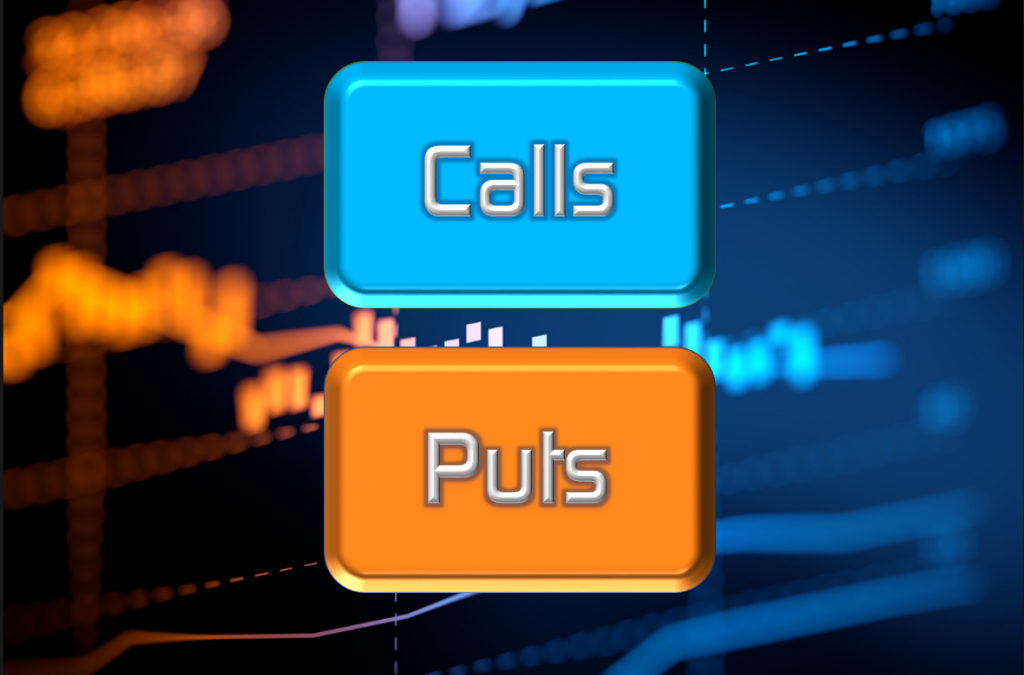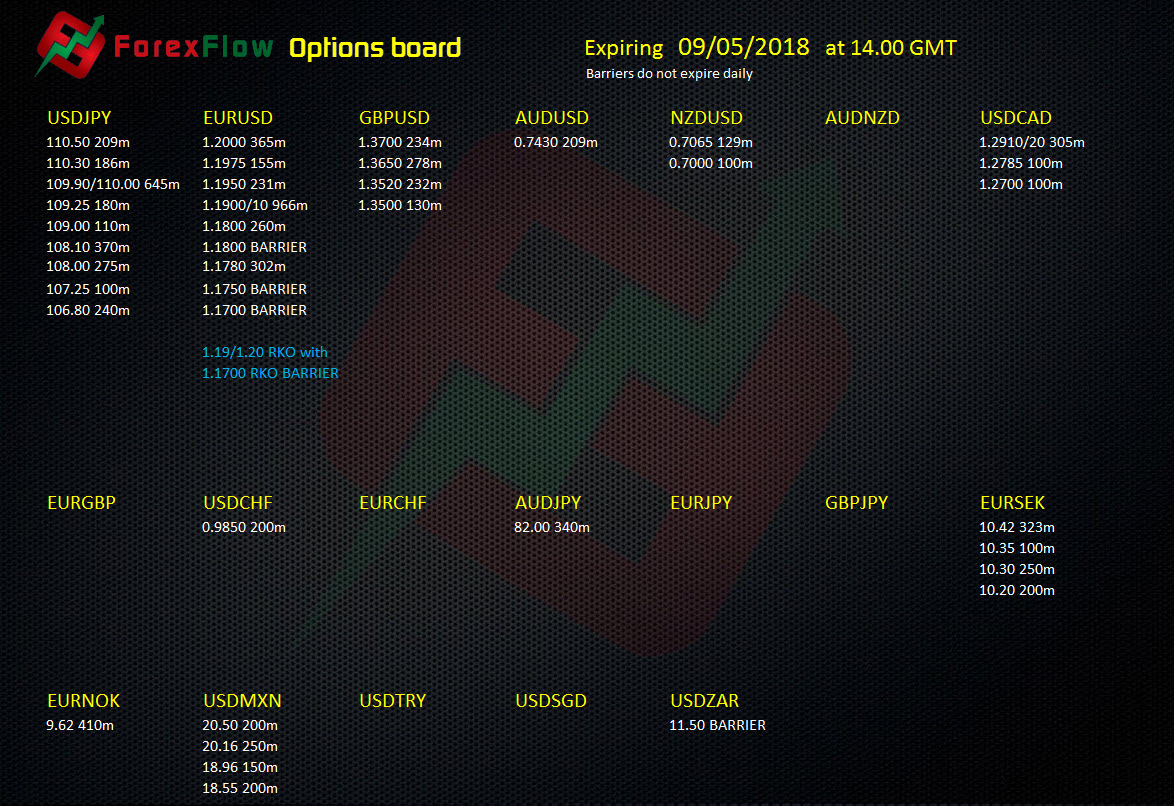Forex options expiring at the 10am (14.00 GMT) New York cut 9 May 2018
We’ve got something new for you today on the options board. We have some normal barriers in EURUSD but there’s also some Reverse Knock-Out (RKO’s) in play. These are being played in the 1.17 to 1.19/1.20 range. How they work is quite complex as they are a play on long gamma/delta, i.e as the price moves it creates a larger position. In this case the position grows as the price moves higher towards 1.19/1.20, and the knock-out barrier is at 1.1700. I’m no expert on these types strategies but I believe that makes these options are puts. I’m hoping K-man will be along soon to add to the conversation as he’s more knowledgeable than I am. The long and short of it is that there’s good interest to keep the price contained in the 1.17-1.20 range but the position and payout grows larger the closer the spot price gets to 1.1700 without hitting the barrier. The basis behind the trade is that it’s a very cheap strategy to buy and your risk is limited. I’ve added it to the board but kept it separate from the other options.
Here’s K-man with the gold;
Basically there are a few possibilities to put up RKO’s : I’ll try to keep it simple…. Basically the buyers of RKO puts hope it stops ahead of 1.17, the buyers of the calls want the 1.17 to get knocked out. It’s also important to know who’s on which side of the trade : market taker( client, spec..) , market maker( bank, broker)
1. Buy calls/sell puts 1.19/1.20 with a lower RKO to cheapen the option or not wanting the long calls anymore if the lower level breaks. These will create more long gamma/delta around/above the call strikes as time evolves towards the expiry date( higher time value/chance to be above the strike), less as we move towards the RKO strike as the calls lose value on price, time decay and lose delta as the chance of being above the strike diminishes. This type will be used by specs thinking to find a bottom between the strikes and a subsequent move back up before expiry, or corporates with EUR payables or USD receivables trying to maximise the FX rate.In this case we shouldn’t expect to much defence of the 1.17 barrier by the market taker as they don’t really want to exercise the 1.19/1.20 calls, being able to buy cheaper cash. The market maker will try to defend the 1.17 though to try to rake up the premium of the call or to be able to exercise the put the client sold to him.
2. Buy puts/sell calls 1.19/1.20 with the lower RKO. These will also cheapen the option as the buyer is taking the risk getting knocked out, the seller gets less premium but will hope for a lower EURUSD in the meantime. In this case the gamma/delta increases on the way down with price/time/exercise ratio and diminishes on the way back up for the market taker. This play is put up by specs accompanying the move lower but thinking the move will stop ahead of 1.17 or corporates with possible but not sure receivables in EUR or with a higher risk profile willing to have a gamble on higher returns if in the range( Famous in USDJPY with Japanese corporates in the 2000-2010 period). Here, compared to scenario 1, the battle is opposite. The market taker will try to defend the 1.17 to get the premium as if touched the option becomes worthless. The market maker will try to knock it out as if the option remains live till expiry .
As time goes by and expiry nears, the gamma(at/above to the strike) will gradually increase and provide liquidity. At the knock out price, time will be a decisive factor as the chance or risk of getting knocked out will increase exponentially and fierce battles could unfold.
For more information on this type of option play and others, read our explanation of Forex options and their impact on currency markets.
- The last NFP competition of 2022 - December 1, 2022
- Will this month’s US NFP be a horror show? - October 4, 2022
- US NFP competition – Do you think there’s going to be a turn in the US jobs market? - August 31, 2022




oh thank you ryan..please update us kman on these types
Thanks again. I need to take some time to go thru after work.
Basically there are a few possibilities to put up RKO’s : I’ll try to keep it simple…. Basically the buyers of RKO puts hope it stops ahead of 1.17, the buyers of the calls want the 1.17 to get knocked out. It’s also important to know who’s on which side of the trade : market taker( client, spec..) , market maker( bank, broker)
1. Buy calls/sell puts 1.19/1.20 with a lower RKO to cheapen the option or not wanting the long calls anymore if the lower level breaks. These will create more long gamma/delta around/above the call strikes as time evolves towards the expiry date( higher time value/chance to be above the strike), less as we move towards the RKO strike as the calls lose value on price, time decay and lose delta as the chance of being above the strike diminishes. This type will be used by specs thinking to find a bottom between the strikes and a subsequent move back up before expiry, or corporates with EUR payables or USD receivables trying to maximise the FX rate.In this case we shouldn’t expect to much defence of the 1.17 barrier by the market taker as they don’t really want to exercise the 1.19/1.20 calls, being able to buy cheaper cash. The market maker will try to defend the 1.17 though to try to rake up the premium of the call or to be able to exercise the put the client sold to him.
2. Buy puts/sell calls 1.19/1.20 with the lower RKO. These will also cheapen the option as the buyer is taking the risk getting knocked out, the seller gets less premium but will hope for a lower EURUSD in the meantime. In this case the gamma/delta increases on the way down with price/time/exercise ratio and diminishes on the way back up for the market taker. This play is put up by specs accompanying the move lower but thinking the move will stop ahead of 1.17 or corporates with possible but not sure receivables in EUR or with a higher risk profile willing to have a gamble on higher returns if in the range( Famous in USDJPY with Japanese corporates in the 2000-2010 period). Here, compared to scenario 1, the battle is opposite. The market taker will try to defend the 1.17 to get the premium as if touched the option becomes worthless. The market maker will try to knock it out as if the option remains live till expiry .
As time goes by and expiry nears, the gamma(at/above to the strike) will gradually increase and provide liquidity. At the knock out price, time will be a decisive factor as the chance or risk of getting knocked out will increase exponentially and fierce battles could unfold.
What a great explanation. Thank you very much!